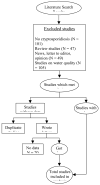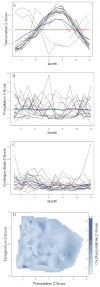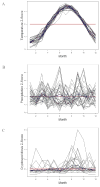Seasonality of cryptosporidiosis: A meta-analysis approach
- PMID: 19328462
- PMCID: PMC2732192
- DOI: 10.1016/j.envres.2009.02.008
Seasonality of cryptosporidiosis: A meta-analysis approach
Abstract
Objectives: We developed methodology for and conducted a meta-analysis to examine how seasonal patterns of cryptosporidiosis, a primarily waterborne diarrheal illness, relate to precipitation and temperature fluctuations worldwide.
Methods: Monthly cryptosporidiosis data were abstracted from 61 published epidemiological studies that cover various climate regions based on the Köppen Climate Classification. Outcome data were supplemented with monthly aggregated ambient temperature and precipitation for each study location. We applied a linear mixed-effect model to relate the monthly normalized cryptosporidiosis incidence with normalized location-specific temperature and precipitation data. We also conducted a sub-analysis of associations between the Normalized Difference Vegetation Index (NDVI), a remote sensing measure for the combined effect of temperature and precipitation on vegetation, and cryptosporidiosis in Sub-Saharan Africa.
Results: Overall, and after adjusting for distance from the equator, increases in temperature and precipitation predict an increase in cryptosporidiosis; the strengths of relationship vary by climate subcategory. In moist tropical locations, precipitation is a strong seasonal driver for cryptosporidiosis whereas temperature is in mid-latitude and temperate climates. When assessing lagged relationships, temperature and precipitation remain strong predictors. In Sub-Saharan Africa, after adjusting for distance from the equator, low NDVI values are predictive of an increase in cryptosporidiosis in the following month.
Discussion: In this study we propose novel methodology to assess relationships between disease outcomes and meteorological data on a global scale. Our findings demonstrate that while climatic conditions typically define a pathogen habitat area, meteorological factors affect timing and intensity of seasonal outbreaks. Therefore, meteorological forecasts can be utilized to develop focused prevention programs for waterborne cryptosporidiosis.
Figures








Similar articles
-
Seasonality of rotavirus in South Asia: a meta-analysis approach assessing associations with temperature, precipitation, and vegetation index.PLoS One. 2012;7(5):e38168. doi: 10.1371/journal.pone.0038168. Epub 2012 May 31. PLoS One. 2012. PMID: 22693594 Free PMC article.
-
Analysis of vegetation dynamics, drought in relation with climate over South Asia from 1990 to 2011.Environ Sci Pollut Res Int. 2019 Apr;26(11):11470-11481. doi: 10.1007/s11356-019-04512-8. Epub 2019 Feb 26. Environ Sci Pollut Res Int. 2019. PMID: 30806929
-
Projected local rain events due to climate change and the impacts on waterborne diseases in Vancouver, British Columbia, Canada.Environ Health. 2019 Dec 30;18(1):116. doi: 10.1186/s12940-019-0550-y. Environ Health. 2019. PMID: 31888648 Free PMC article.
-
Local weather, flooding history and childhood diarrhoea caused by the parasite Cryptosporidium spp.: A systematic review and meta-analysis.Sci Total Environ. 2019 Jul 15;674:300-306. doi: 10.1016/j.scitotenv.2019.02.365. Epub 2019 Mar 28. Sci Total Environ. 2019. PMID: 31004904
-
Cryptosporidiosis in children in Sub-Saharan Africa: a lingering challenge.Clin Infect Dis. 2008 Oct 1;47(7):915-21. doi: 10.1086/591539. Clin Infect Dis. 2008. PMID: 18715159 Free PMC article. Review.
Cited by
-
Effects of the 1997-1998 El Niño episode on community rates of diarrhea.Am J Public Health. 2012 Jul;102(7):e63-9. doi: 10.2105/AJPH.2011.300573. Epub 2012 May 17. Am J Public Health. 2012. PMID: 22594750 Free PMC article.
-
Seasonal synchronization of foodborne outbreaks in the United States, 1996-2017.Sci Rep. 2020 Oct 15;10(1):17500. doi: 10.1038/s41598-020-74435-9. Sci Rep. 2020. PMID: 33060743 Free PMC article.
-
A review of the global burden, novel diagnostics, therapeutics, and vaccine targets for cryptosporidium.Lancet Infect Dis. 2015 Jan;15(1):85-94. doi: 10.1016/S1473-3099(14)70772-8. Epub 2014 Sep 29. Lancet Infect Dis. 2015. PMID: 25278220 Free PMC article. Review.
-
The Risk of Reported Cryptosporidiosis in Children Aged <5 Years in Australia is Highest in Very Remote Regions.Int J Environ Res Public Health. 2015 Sep 18;12(9):11815-28. doi: 10.3390/ijerph120911815. Int J Environ Res Public Health. 2015. PMID: 26393636 Free PMC article.
-
High Occurrence of Zoonotic Subtypes of Cryptosporidiumparvum in Cypriot Dairy Farms.Microorganisms. 2022 Feb 28;10(3):531. doi: 10.3390/microorganisms10030531. Microorganisms. 2022. PMID: 35336110 Free PMC article.
References
-
- Adegbola RA, Demba E, De Veer G, Todd J. Cryptosporidium infection in Gambian children less than 5 years of age. J Trop Med Hyg. 1994;97:103–7. - PubMed
-
- Agnew DG, Lima AA, Newman RD, Wuhib T, Moore RD, Guerrant RL, Sears CL. Cryptosporidiosis in northeastern Brazilian children: association with increased diarrhea morbidity. J Infect Dis. 1998;177:754–60. - PubMed
-
- Alterholt TB, LeChevallier MW, Norton WD, Rosen JS. Effect of rainfall on giardia and crypto. J Am Water Works Assoc. 1998;90:66–80.
-
- Assadamongkol K, Gracey M, Forbes D, Varavithya W. Cryptosporidium in 100 Australian children. Southeast Asian J Trop Med Public Health. 1992;23:132–7. - PubMed
Publication types
MeSH terms
Grants and funding
LinkOut - more resources
Full Text Sources
Medical

